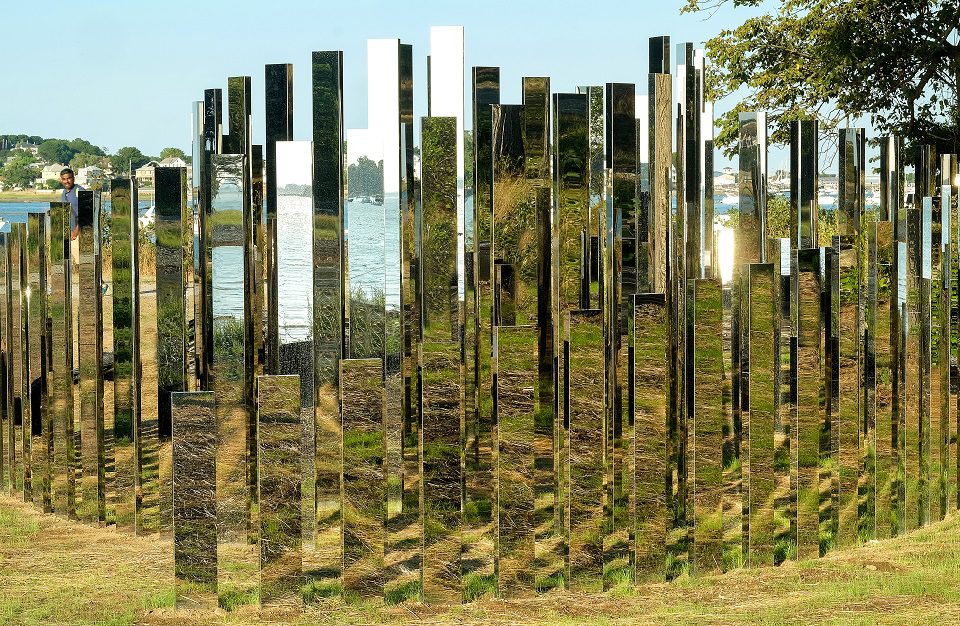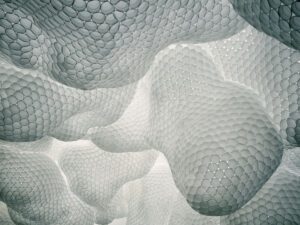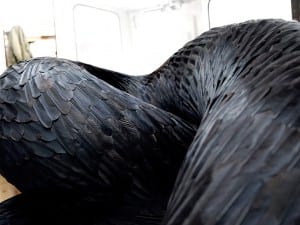This September, internationally celebrated contemporary artist, Jeppe Hein has created a new site-specific labyrinth installation at Massachusetts’ World’s End in Hingham. A New End is part of a new two-year outdoor art initiative, Art and The Landscape, presented by The Trustees and curated by guest curator Pedro Alonzo. Aesthetica catch up with the artist about the inspirations behind the piece and intentions for audience interaction.
A: How does your use of material encourage different things from each audience? For example, how does the use of mirror in this particular exhibition encourage reflection and individual thoughts about art and the landscape?
JH: I choose materials, or to be more precise, certain properties of materials, that translate my idea in the best way and establish channels of communication between my art, the spectators and the environment these two meet in. When I for example use water, I focus on the ephemeral qualities of it. It is present and perceivable in one moment through eyes, ears, skin and taste, and then in the next moment it changes or vanishes completely, harshly interrupting the spectators sensation and redirecting her / his attention to her- / himself.
Mirror is somehow different and very special. I wouldn’t consider it a material. When I use mirror it is always about the reflectivity. Through the focus on this property it becomes more or less a vehicle allowing me to construct utopian and unreal spaces within a reality the spectator lives in. Once a mirrored sculpture is in place, the viewer will not focus on the material, but rather on the form of and the reflection from the object. At the same time my mirror sculptures construct and dissolve space in the eye of the viewer, and they mostly blend into the surrounding so well that viewers have difficulties in deciding which part of what they see is real whilst being lifted to a higher level of awareness of the world and themselves.
In addition, I understand the landscape as a kind of material that I work with too. At the Island of World’s End you are completely located in a beautiful landscape. That is why I create a slowly rising spiral: the more you go into the labyrinth the more you disappear until you are on your own in the middle of nature.
A: Where do influences from minimalism and conceptual art come into play within this event?
JH: Minimalism or minimalist art as well as conceptual art of course have a great influence into my art production in general. But within this event I had no intention to use either of the two as a direct reference. For me these are rather part of my cultural framework – like a language or so – that I come equipped with no matter what I do.
A: Where do you think boundaries are drawn between functionalism and aestheticism?
JH: I wouldn’t draw any hard lines between those two. My benches for example are very “functional.” Maybe not in the sense of sitting but in the sense of changing people’s awareness and perception of their immediate environment. Hence aestheticism referred back to its Greek word sense of “aisthesis – perception, sensation” becomes functional in itself. It is the function of the bench to change the way people see their world. My work in general shall sharpen people’s senses, raise their awareness and perception of their surroundings and encourage a dialogue between them. Ideally it fosters communication, sensations and empathy that people will pass on to others.
A: How does the notion of the labyrinth come into play within this piece, and how did you begin the processes of its design?
JH: I see the labyrinth as a symbol of life. How to find your way through life? You experience it simply by walking your way. With my artwork A New End it is a little bit the same: approaching the artwork it is a kind of an explosion of mirrors and the surroundings and when the audience come closer to going in, they will be in a way drag in the middle of the labyrinth. The idea is that when you find the middle, which could be a situation in life, you will again experiencing something. You can choose between three possibilities to go forward and you will start again reflecting within the new experience of taking a new path. But sometimes there are dead ends and the viewer has to find out how to come back.
A: Why do you think it’s relevant, or necessary, for the public to physically engage with the artwork?
JH: Rather than passive perception and theoretical reflection, the visitor’s direct and physical experiences are more important to me. Viewer participation is essential in my works. I want to invite people to take an active role. That’s why it is always interesting to see people use an artwork in unexpected ways. I don’t want to prescribe the concept of use and one of the reasons I like to work in public space is the variety of the public and the pluralism of different ways of behaviour.
A: What kind of dialogues do you expect to manifest in your viewers, either in verbal communication or in consciousness?
JH: I think there is a lot of things happening in the spectator during and after encounters with my artwork. Surely one important aspect is that artworks in public space open up new possibilities for the spectators to lose his / her timidity and respect towards art, whilst in museums the relationship between the viewer and the artwork is already defined to a strong degree.
When people see an art piece developed and integrated in public space, it is often easier for them to get first access to it and thus their approach to art in general changes. This does not mean that they lose the respect for the artwork though. The opposite is the case. People integrate this experience more into their lives. And that is actually another important effect: by carrying this new experience and awareness into their lives, this will probably change their attitude towards many other things also – hopefully to the better.
A: What plans do you have after this exhibition?
JH: I am currently working on a solo exhibition at the Museet for Religiøs Kunst in Lemvig, Denmark. In addition, I am realising several commission work projects in Hong Kong and London. All upcoming projects are also announced on my website jeppehein.net, so please check it regularly!
Jeppe Hein: A New End runs until October 2017 at World’s End in Hingham, MA.
Find out more: www.thetrustees.org
Credits:
1.Installation view of Jeppe Hein, A New End, 2016, at World’s End in Hingham, MA. Part of the Art and The Landscape series presented by The Trustees of Reservations. Photo by Mark Gardner, Courtesy of The Trustees.





